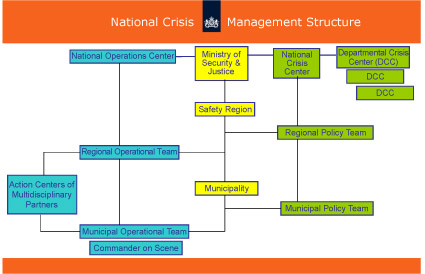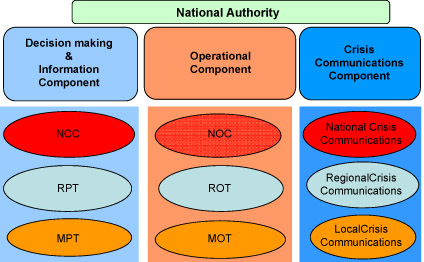 The Netherlands’ current state of crisis management is the result of several large incidents that occurred during the last decade of the 20th century. These incidents influenced crisis management – disaster relief, response, and recovery – and led to some legislative consequences, including passage of the nation’s Safety Regions Act (2010), which distributes the Netherlands’ emergency services into 25 territorial units.
The Netherlands’ current state of crisis management is the result of several large incidents that occurred during the last decade of the 20th century. These incidents influenced crisis management – disaster relief, response, and recovery – and led to some legislative consequences, including passage of the nation’s Safety Regions Act (2010), which distributes the Netherlands’ emergency services into 25 territorial units.
Another consequence was that the role of the mayors responsible for the safety regions – i.e., the territorial units of emergency services and public health services – was redefined, as was the role of the safety regions themselves. Professionals now are in charge of the coordination.
Another change was that the coordination previously provided by provincial authorities was replaced by coordination at the national level. The coordination responsibility now falls on the Minister of the Ministry of Security and Justice, who is assigned an executive mandate that keeps him or her in direct contact with the prime minister and other relevant ministers.
Three Key Principles That Guide Crisis Management Three underlying principles are the key components supporting the National Crisis Management Structure of The Netherlands. First, crisis management is carried out via a bottom-up approach. When a disaster or crisis affects only one municipality, the local mayor is responsible. However, if a disaster extends to more than one municipality, the coordinating mayor of the safety region is also immediately responsible, and is vested with decision-making powers. Because the safety region and police region overlap, the coordinating mayor also serves as head of the police region.
The second principle mandates that the structure be divided into three levels – national, regional, and municipal – that work in close relationships with one another on all aspects of decision making, the sharing of operational information, capacity management, and crisis communications. Only when the five national interests – Physical Security, Economic Security, Environmental Security, Social and Political Security, and Territorial Security – are threatened does the Ministry of Security and Justice – in this case, the National Crisis Center (NCC) – step in to coordinate.
The third principle requires that, on each level, crisis management must be a multidisciplinary effort. This means that ministries on the national level and operational organizations on the regional and municipal levels have a shared responsibility in mastering the crisis and working together in multidisciplinary units.

Three Varying Levels of Responsibility The “Three Principles” are paralleled, for operational purposes, at three levels of governmental responsibility – Municipal, Safety Region, and National. Following are brief descriptions of the responsibilities assigned to each.
Municipal Level – Action Centers and the LCMS: At the scene of a crisis incident, the operational commanders of fire and rescue brigades remain in charge. The “Commander on Scene” always reports to the Municipal Operational Team, which consists of representatives of the emergency services (fire brigade, ambulance, and police services) and of the municipality, and is headed by the mayor. In addition to the Municipal Operational Team, an information manager and a crisis communications officer are assigned. Representatives from each service are supported by their own action centers when and where specific tasks can be performed: (a) for the police, an action center for mobility; (b) for the fire brigade, an action center for hazardous materials; (c) for the ambulance service, an action center for the reserving of hospital capacity; and (d) the municipality itself, for the registration of casualties.
During an incident, the information manager is responsible for gathering all necessary information from the organization and entering it into the LCMS (landelijk crisismanagement systeem – the Dutch national crisis management system). From this information, a real-time operational picture can be derived to support decision making not only on the ground but also throughout the process. The LCMS is also used on the regional level and, through an interface, with the national information system used at the National Crisis Center. By providing real-time status information to both the municipal and regional levels, the volume of telephone calls is reduced, thereby preventing the system from overloading.
Using the information collected by the information manager, the crisis communications officer is responsible for supplying necessary information – updates about the event, advice on what to do next (calls to action) – to the public and to the media. The crisis communications officer is often in direct contact with his or her colleagues at the national and regional levels.
At this same level, decision making is the responsibility of the Municipal Policy Team, which is composed of the same representative base as the Municipal Operational Team. The LCMS enables the other, more senior, levels to remain informed of the decisions that are being made and to determine if they should provide additional assistance. (If the affected area covers more than one municipality within a safety region, the safety region level steps in to action.)
Safety Region Level – Liaison & Operational Responsibilities: The mayor of what is considered to be the “most important” municipality in the region, and head of the police region, is also the “president” of the safety region and head of the Regional Policy Team. The mayors of all municipalities within a safety region are members of the Team as well. The safety region regroups the emergency services and the public health authorities. Each safety region has liaison officers assigned to work with other operational organizations, such as: (a) the Organization for National Infrastructure (for the highways, major waterways, and large navigation channels); (b) the Water Boards (regional water authorities); and (c) the regional military command.
The Regional Policy Team and the coordinating mayor of the safety region jointly direct the relief operations. On the operational level, a Regional Operational Team is charged with management of the disaster. In effect, the Regional Policy Team and Regional Operational Team carry out the same tasks and are structured in the same multidisciplinary composition as the Municipal Policy Teams and Municipal Operational Teams – but on a regional scale. The transfer of responsibility from the municipal level to the regional is relatively simple because both levels use the same information system (LCMS).
There are three particular situations in which the regional authorities will transfer management of a disaster to the national authorities:
- The Minister of Security and Justice specifically mandates that the management be assumed by the national authorities from the regional authorities;
- Emergency legislation dictates that a competent authority assigned at the national level should assume the management of the disaster response; and/or
- The affected area extends beyond a single safety region.
The National Level – The Linking Pin & An Emphasis on Coordination: On the National level, the NCC of the Ministry of Security and Justice is responsible for national coordination during major disasters and serves as the National Point of Contact for international organizations such as the European Union, the United Nations, and NATO (North Atlantic Treaty Organization). In addition, each of the Netherlands’ 11 ministries has its own Departmental Crisis Coordination Centre. During a disaster, the representatives of those ministries convene at the NCC to take their place in one of the three decision making bodies: (a) the directors of the NCC and Departmental Crisis Coordination Centre (DCC); (b) the Director-Generals of the different ministries represented (ICCB); and (c) the Ministers themselves (MCCB). In ways comparable to the modes of operation followed at the regional and municipal levels, all decision-making units are supported by crisis communications officers and information managers. The decision-making units also can rely on specific advice provided by national expertise organizations – for example, on topics related to nuclear threats, pandemics, flooding, or cyber concerns.
The National Operations Center serves as the linking pin for the national coordination of operational capacity by, among other things:
- Advising the government if and when demands for operational capacity conflict in any important way;
- Organizing the effective and efficient deployment of emergency personnel and services in the event of a disaster, crisis, or large-scale operational incident; and
- Coordinating international assistance – liaison officers of the emergency services and of the Army are based permanently at the National Operations Center.

To briefly summarize: The Netherlands’ national authority for crisis management is made up of three major components: (a) the administrative process (decision making and information); (b) the operational process; and (c) crisis communications. On all three levels – municipal, safety region, and national – units are responsible for executing their assigned tasks in close cooperation with one another. These units are the basic fuel, more or less, that makes the system run – both effectively and efficiently.
____________
For additional information on: The Netherlands Ministry of Security and Justice, visit http://www.government.nl/ministries/venj
________________________ Willy Steenbakkers is the Senior Safety and Security Advisor at the Kingdom of the Netherlands' National Crisis Center, Ministry for Security and Justice – National Coordinator Counterterrorism and Security. He is also the Senior Project Manager, Safety and Security, at 1 CIMIC Battalion; and Civil Military Cooperation Battalion Captain of the Royal Netherlands Army. He previously served as: a participant in the International Visitor Leadership Program (IVLP); Program Manager for NL-Alert for Public Warning; Program Manager for the Ministry of the Interior’s C2000 communication network; and Management Consultant for the Ministry of Defense. He holds a Bachelor of Business Administration degree, Industrial Engineering & Management Studies, from the Technical University of Eindhoven.
